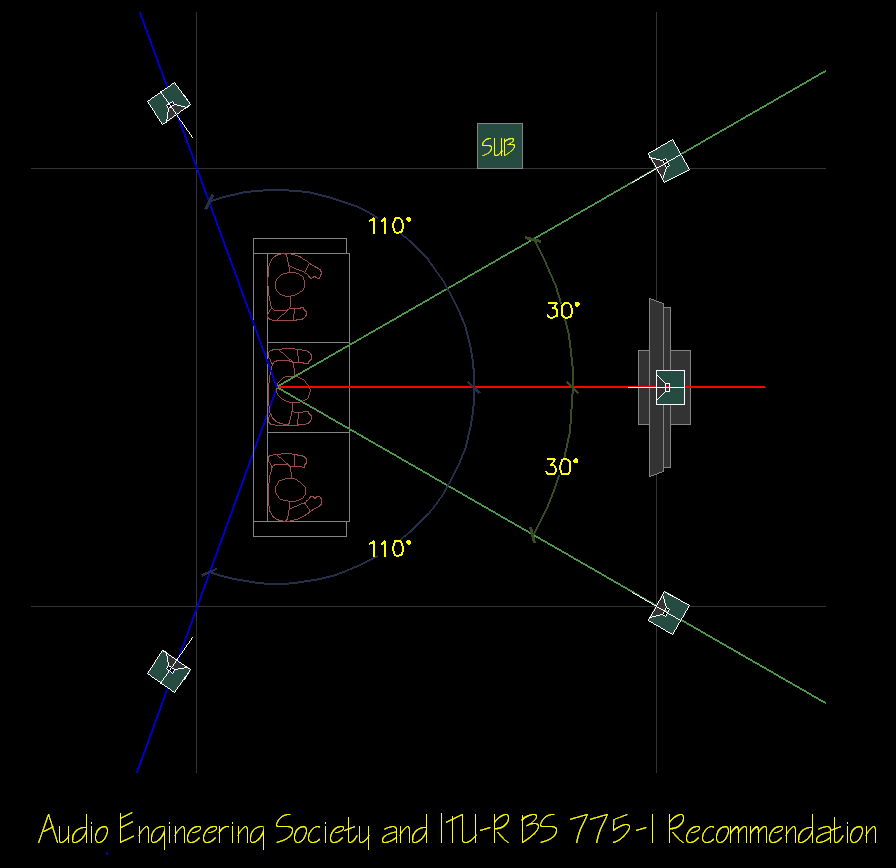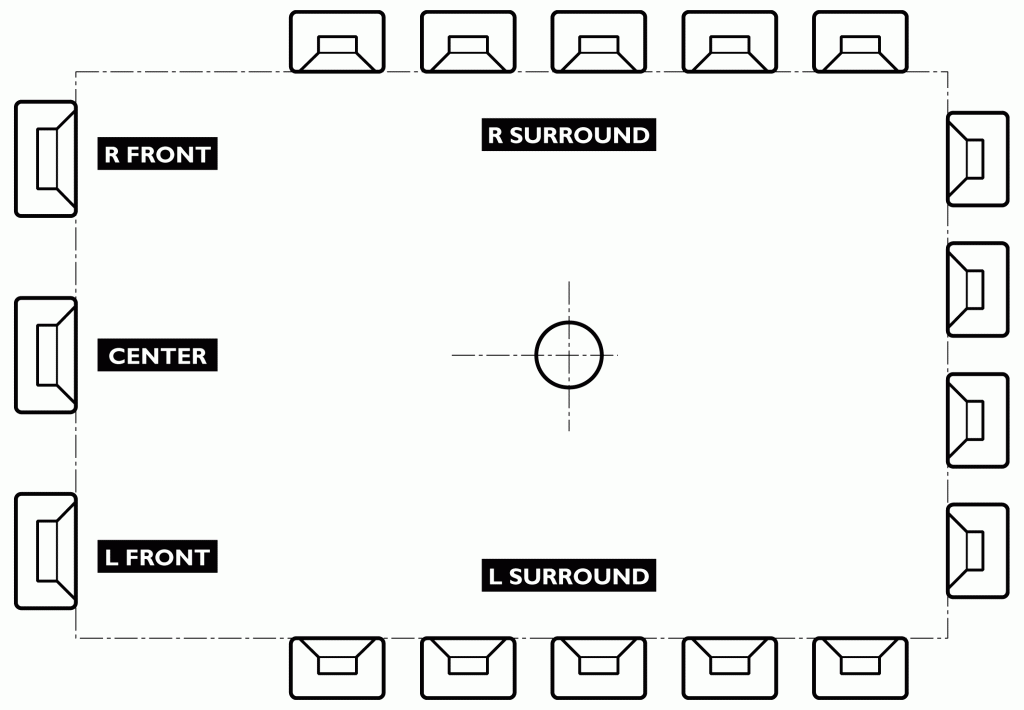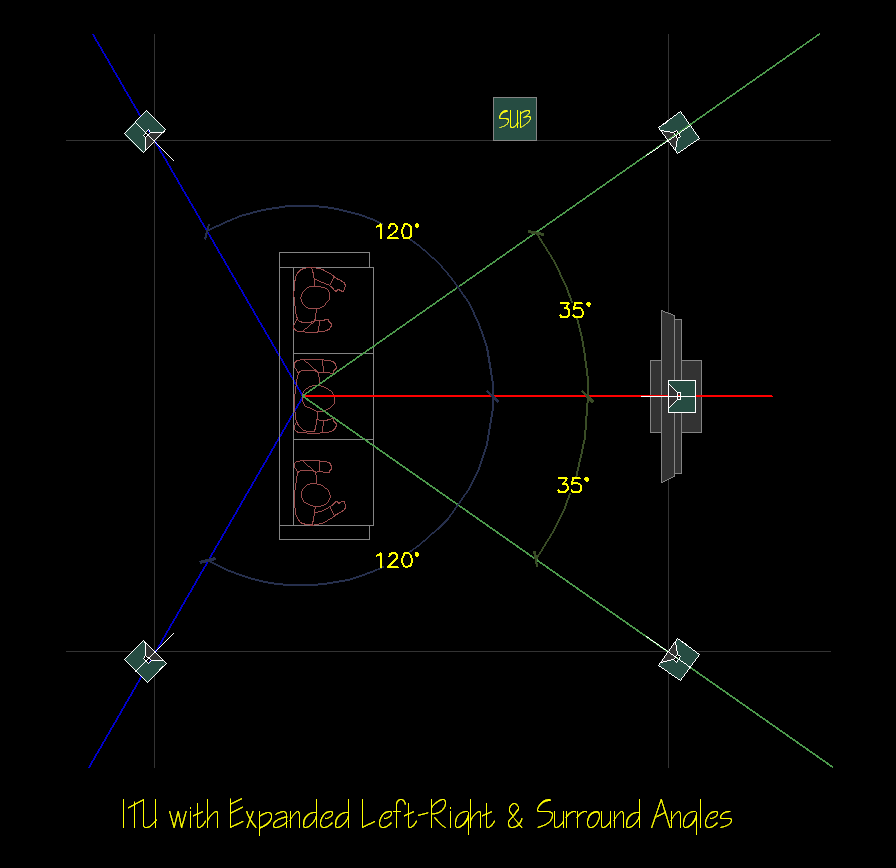Home Theater: Surround Sound Speaker Placement
How to arrange the 5.1 channel surround sound speakers in your home theater.
Check out our Complete Guide to Home Theater Acoustics for more information on how to acoustically tune your home theater.
The most critical foundation of any successful home theater setup is the proper location and configuration of the loudspeakers, listener seating position, and video screen. Our human hearing systems are capable of localizing many sound sources to create a detailed image of our surroundings based on audio alone. Film, television, and video game producers understand this and use their medium’s soundtrack to create a sense of drama, location, and environment. When a home theater is configured properly, viewers will experience a distinct, immersive soundscape.
This article will not cover the selection of specific audio equipment (loudspeakers, receivers, etc.) or the variety of surround sound technologies in use (DTS, Dolby Digital, etc.) The internet already has a wealth of information about those subjects. Instead, we will investigate the proper location and arrangement of this equipment. This article also focuses on 5.1 channel systems because they are -by a huge margin- the most common configuration. However, 7.1 and 10.1 channel systems are also available.
Television (Screen) Position:
The necessary size (measured at the diagonal, in inches) of a television display for your home theater is a function of the typical viewing distance from it. Typically, a longer viewing distance will require a larger screen to produce the same relative image size and perceived resolution.
Moving the seating position closer to the screen is a much less expensive alternative to buying a bigger TV, and will produce the same effective result for the viewer. Moving too close, however, will reveal the limitation of current screen resolution rates, yielding a pixilated image.
For current 1080p displays, the ideal viewing position is between 2 times and 3 times the diagonal screen measure. So, for a 50” TV, the ideal seating location is between 8 feet and 12 feet away. Your viewing distance should not exceed 3 times the diagonal screen dimension.
Viewer position should also face straight, on-axis with the display.
Center Channel Position:
Film sound designers will use the center speaker channel to reproduce speech from the on-screen actors. Therefore, the ideal location for this speaker is as close to the screen as possible, on-center. It could be place directly above or below the display. Alternatively, if your screen has several inches of gap between the bottom of the bezel and the top of its stand, you may be able to place the speaker directly behind the screen.
Left & Right Front Speaker Position:
The front left and right speaker channels in a 5.1 surround sound system are typically used for the film score and on-screen sound effects. When playing back stereo music (CDs, mp3’s, streaming music) or other 2-channel sources, these speakers will be the only ones in operation.
A correct angular dimension will produce a very distinct “stereo image” for this audio. This means that your auditory system will process the sounds from these two speakers as a continuous line of sources before you. You will therefore be able to pick out musical instruments or sound effects from a distinct position where there is no loudspeaker present. To produce this “stereo image” effect, you will need to pay very careful attention to the angle and distance of your front left and right loudspeakers.
The Audio Engineering Society (AES) and International Telecommunication Union (ITU) have thoroughly studied a great number of possible arrangements for loudspeaker positions and angles. The fruit of their research is the ITU-R BS 775 Recommendation. This loudspeaker arrangement has proven in blind listening tests to produce the most accurate spatial imaging effects of any configuration. The AES and ITU recommends front left and right speaker channels be located 30 degrees to the left and right of the center.
The following sketch shows the ideal loudspeaker and listener position layout, according to AES and ITU:
This loudspeaker positioning will produce a very distinct stereo image at the specific point where an equilateral triangle is formed. This point is called the “sweet spot.” You will clearly experience the stereo image effect once you have entered this sweet spot.
Moving to the right or left of the sweet spot causes this effect to break down as the speaker angle and distance relationships are no longer equal. This poses a problem, since you will want to watch movies or sports events with friends (who are NOT in the sweet spot)!
For this reason, I’d like to propose a slight modification to the this speaker arrangement. Positioning the speakers slightly further out, at 35 degrees from center, will create a wider image and a broader sweet spot. This subtle modification will improve the listening conditions for everyone else in the space, but at the expense of slightly less distinct sweet spot in the center.
AcousticsFREQ recommends:
- Front left and right speaker channels be located exactly 35 degrees to the left and right of the center.
- Left, Right, and Center speakers must all have equal distance to the listener position.
- Speaker height should be equal to the center of the video display height.
- Speaker aiming should be toward the center of listener seating position area.
Surround (rear) Speaker Position:
The left and right surround channels, sometimes called rear speakers, are used to produce the ambience, room sound, and behind-listener effects in film and video games. They are also used in televised sporting events to reproduce crowd noise, giving viewers the sensation being in the front row of a stadium.
A professional, commercial cinema will have many surround speakers spaced evenly along the mid to rear side walls and rear wall. This allows the film sound designers to generate effects at a great variety of angles. It also helps ensure good listening geometry for viewers throughout a large theater.
Your home theater sound system will –unfortunately- be much less advanced than the commercial cinema’s. Most home theater setups try to accomplish the entire side and rear surround soundtrack with two speakers. This arrangement is called 5.1. The AES and ITU recommended placement of the surround (rear) speakers at 110 degrees from center.
The 5.1 format does not separate effects originally intended as behind-listener from those intended to as lateral. This separation occurs with 7.1 and 10.1 systems, where 2 speakers are to be placed at a larger angle (up to 150 degrees), further behind the listener. Since most film and video game surround mixing includes content intended as behind-listener effects, I propose that the “surround” channels of a 5.1 system be positioned slightly further back, at 120 degrees from center. This positions them between points for surrounds and rears in a 7.1 system and is a better approximation of the original commercial cinema surround sound experience.
NOTE: It is NOT possible to achieve the correct surround sound speaker angles when the listener seating position is all the way back against the rear wall.
AcousticsFREQ recommends:
- Surround (rear) speaker channels located exactly 120 degrees to the left and right of center.
- If possible, surround speakers must have equal distance to the listener position as the front channels.
- Speaker height should be slightly elevated to achieve unobstructed line-of-sight to listener’s ears (over chair back).
- Speaker aiming should be slightly off-center of listening position area (see below).
A drawing of our recommended speaker, listener and video display positions:
Subwoofer (Low Frequency Effects)
The subwoofer channel (the .1 in 5.1) of a surround sound system is used to fill out the “bottom end” of the audio spectrum. Its very large speaker diaphragm is able to efficiently produce lower frequency acoustic energy than standard-sized speakers. This low frequency sound (bass) is also much less directional in nature, making its placement location more flexible.
The main consideration for subwoofer placement is how the location affects the overall bass response in the room. Small rooms exhibit modal resonances and standing waves, unique to the size and shape of each individual space. This is why one-size-fits-all or rule-of-thumb approaches are tricky.
The subwoofer could be placed in a number of areas at the front and side walls and still produce excellent results. Experiment with different location to find the position that yields the most balanced, even response.
AcousticsFREQ recommends:
- Position the subwoofer in the front half of the space
- Leave at least 1 foot of space between subwoofer and wall
- Do not place subwoofer in corner
- Experiment with different locations to find the most balanced, even bass response.
TIP: You can draw your home theater space in CAD to easily check the distances and angles for various features. Dassault Systems (the makers of SOLIDWORKS) offer a free 2D CAD program called Draftsight
You can download the above speaker placement CAD drawing file in .dwg format (opens in AutoCAD or Draftsight) HERE







What about the height of the speakers? listeners ear height? Thanks!
Gary, I prefer the fronts to be on a horizontal line with the center of the Display, which puts the stereo aural image in the visual display. This is obviously impossible with the center channel, which should go right above or below your display. The rear surrounds are typically elevated, but I think that might be for practical purposes.
Hi, great article. Could you imagine to suggest the placement of ceiling speakers to reproduce the Dolby atmos? Thanks
Marco, Thanks for the suggestion. I have not thought about that one.
hi, thanks for the lovely article.
Very well explained. Very nice article.
Thanks.
Love to know your thoughts on 7.1.4 ceiling speaker locations (i.e maybe an update on this page?)
Regards Rob
Ahh yes, Dolby Atmos! Some day my friend!!
Should center speaker be tilted to point upward when it is placed underneath my screen?
That’s not a bad idea!
That’s so wonderfuly explained.. very informative article..
Thank you friend.
Thank you for the excellent article.
I noted that : NOTE: It is NOT possible to achieve the correct surround sound speaker angles when the listener seating position is all the way back against the rear wall.
If due to size and layout, one has no choice but to have the seated listening position all the way back against the rear wall, what can I do to best make of the area to get the best surround sound as possible?
Thank you!
Not sure how to get L, R, and center speakers to be on same plane as the screen and also be an equal distance from the listener(recommendation #2). Hypotenuse of a triangle is longer than the side. Do I move L and R speakers forward or do I delay timing of speakers?
Good point! I think some A/V receivers have time-delay settings to account for this.